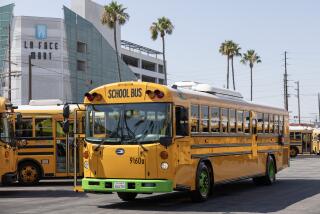Schools Gird for Cuts From Slashed State Budget
- Share via
When county educators talk of drastic budget problems for the 1991-92 school year, they insist--in contrast to past predictions--that they are not crying wolf.
And almost every one of the county’s 43 school districts can point already to the pain that a state cut of $2 billion in funding to schools over the next 18 months will cause to students and teachers, given the fact that 80% or more of their income comes from the state.
Some examples:
* The Grossmont High School district, whose 12 high schools cover most of urban East County, will see average class sizes increase from 31 to 33 students, elimination of one vice principal at each campus, an end to an experimental program for smaller English classes and the cutting of 34 clerical and non-classroom positions. The district needs to cut $6 million from its services, after already cutting $11 million from its $100-million budget this school year.
* In National City, trustees of the elementary school district have voted to stop the reading teacher program, meaning that 29 teachers must hope that regular classroom positions open up in order to avoid being laid off. There will also be fewer nurses, psychologists and administrators as the district tries to eliminate an estimated $1.4-million shortage on top of a $2.3-million cut made last fall to balance a $24-million budget.
* In North County, with a projected $2-million shortfall in its $30-million budget, the San Dieguito Union High School District expects to eliminate the positions of 25 teachers, five counselors, three librarians, five custodians, four clerks and secretaries, and various administrative assistants. Music and graphic arts instruction will also go.
* Oceanside Unified, facing a $4.1-million deficit in a $67-million budget and with a hiring freeze already in place, will end its summer school program, seminars and conferences for teachers and field trips for students, and will eliminate 42 teaching and 10 management positions, despite a projected increase of 500 students next fall.
* The county’s largest system, San Diego Unified, is undergoing a wrenching internal debate over how to cope with an expected $37-million shortage. Although no decisions have been made public, the nation’s eighth-largest urban district has plans to eliminate at least one assistant superintendent, offer early-retirement incentives to teachers and others, and perhaps put some or all of its more than 500 resource teachers back into the classroom. In a symbolic move, Supt. Tom Payzant has told staffers he will not take a $15,000 pay increase due on his $125,000 annual salary July 1.
“This hurts more than you can imagine,” said Jo Ann Smith, Grossmont superintendent, reflecting the views of her colleagues countywide at having to make cuts in academic programs that even now are not considered wholly adequate to turn around years of poor student performance.
Gov. Pete Wilson’s proposed 1991-92 budget hits education hard, reducing per-pupil spending in public schools to 1986 levels after accounting for inflation. School systems would lose about $2 billion in funding during the next 18 months. That includes $500 million in the current budget year because state revenues have dropped so precipitously and $1.4 billion next year if, as Wilson requests, the Legislature suspends provisions of Proposition 98 that ensure that the state budget provide a certain percentage each year for school funding.
Wilson’s budget includes no cost-of-living increases for school districts--the major item that districts rely on for salary and benefit increases--only small increases in several special school programs such as gifted children and integration, and suspension of programs for mentor teachers and reducing class size.
Vista Unified Supt. Rene Townsend expressed frustration with the Proposition 98 suspension because it would rob districts of hoped-for stability in planning budgets.
“The people throughout the educational system really want to be fiscally responsible, and we don’t want to waste money,” Townsend said. “But it’s like trying to plan for a salary that you don’t know what it’s going to be. It’s hard to put a strategy together.”
In addition, most districts are struggling with the effects of having planned programs for this year based on lottery receipts of $170 per student as projected by the state, when in fact actual receipts turned out to be $123 per student because of a drop in lottery sales.
“We took a $100,000 hit right there, and that’s a big stab for us,” said David Blumenthal, superintendent at the tiny Coronado Unified district, with five schools and a $10-million budget. The lottery affected Sweetwater High School district with a reduction of $1.4 million; the Chula Vista Elementary district at $900,000; the Escondido High School district $300,000, and Grossmont at $1.2 million.
On top of that, every district now must maintain considerable reserve funds because of potentially large payments that could be required for the county tax collector. School districts statewide are contesting a new state law that allows counties to charge school districts and other public agencies for collecting and doling out their portion of property tax money.
Should schools lose the legal battle, districts will pay the annual fees to the county. For San Diego Unified, the two-year bill would run $3 million. For Vista Unified, it would run $600,000 out of its $93 million budget. Grossmont would cough up $1 million, Coronado $156,000, Sweetwater $500,000 and National City $112,000.
Districts in fast-growing North County say that continued growth in numbers of students gives them some budget flexibility because the state will continue to pay additional funds for each new student.
“It’s better to grow than not to grow, but inherent in the growth are the problems of hiring new faculty and housing the students,” said Dan Armstrong, administrative assistant for Oceanside Unified.
Despite a projected growth of 500 students, Armstrong said Oceanside plans to increase class sizes at the elementary level from 29 students to 31, while those at the secondary level will grow from 26 to 28 students. That move alone will save $1.26 million out of the $4.1 million the district needs to cut.
Similarly, Fallbrook Union Elementary, which faces a 10% shortfall in a $24-million budget, has three lists of potential cuts, and they all include raising class sizes from 30 to 31 students.
Vista will only hire about 20 new teachers--instead of the 50 to 100 in past years--despite 1,500 more students next year.
Although almost all districts plan to eliminate positions--an inevitability given that upwards of 85% of their budgets involve salaries for employees--most believe they can avoid layoffs by reassigning teachers or clerical workers to posts vacated through retirement or resignation.
“Our intent is not to lay people off, but we won’t be filling a lot of positions,” said John Vugrin, superintendent of Chula Vista Elementary, the state’s largest elementary district with 32 schools. “Right now, we are projecting to employ some new teachers, since we expect 500 new pupils next year, but we don’t know for sure.” The district is considering raising its class size, an action which cuts the number of teachers needed.
For National City, however, layoffs are already a reality.
National City Supt. DeWayne Ouren said that he expects up to 10 layoffs among the 29 teaching positions being eliminated.
“I don’t know if we can keep it any lower through retirement, job sharing, attrition, all of those things,” he said. “This clearly goes against the grain of giving special help for individual kids, but we don’t have any choice.”
School system employees, from teachers to typists to bus drivers, can expect little or no cost-of-living or merit increases next year. Those districts whose contracts tie raises to the state’s cost-of-living provision--such as those in San Diego Unified, National City and Grossmont--will avoid that extra liability.
But, even for those districts that renegotiate salaries every year, the looming financial squeeze may give them added flexibility in confronting their labor unions.
“I don’t want to seem that we are unwilling to be fair with our employees with salaries,” Gene Hartline, assistant superintendent for business services at Escondido Union Elementary district said. “But we have had some severe limitations, both this year and what we’re facing in the future.”
SCHOOL DISTRICT BUDGET WOES
Estimated Shortage Selected Districts 1990-91 Budget For 1991-92 (in millions) (in millions) Chula Vista Elementary $70 $1.8-2 Coronado Unified $10 $0.67 Escondido Elementary $55 $2.2 Escondido Union High School $26 $0.9 Fallbrook Elementary $24 $2.5 Fallbrook Union High School $10 $0.5 Grossmont Union High School $100 $5-6 National City Elementary $24 $1.4 Oceanside Unified $67 $4.1 San Diego Unified $560 $37 San Dieguito Union High School $30 $2 South Bay Elementary $42 zero Sweetwater Union High School $125 $1 Valley Center Elementary $10 $0.3 Vista Unified $93.4 $2.7
Source: Individual school districts
More to Read
Sign up for Essential California
The most important California stories and recommendations in your inbox every morning.
You may occasionally receive promotional content from the Los Angeles Times.










